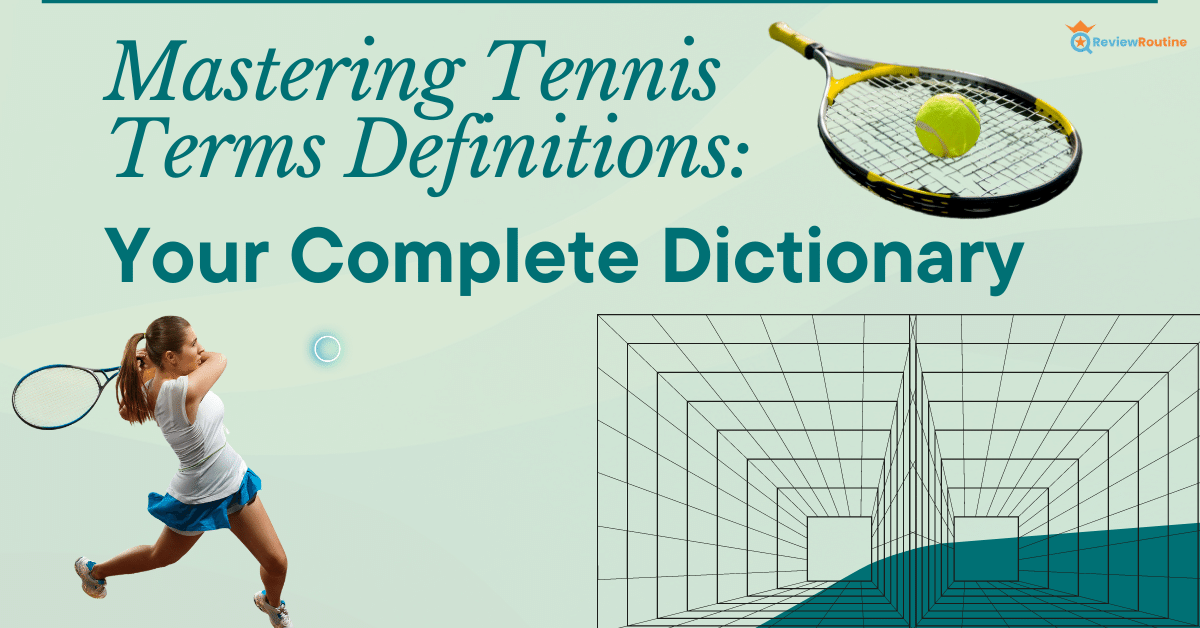Ever found yourself tangled up in the web of tennis jargon while watching a tennis match?
Or maybe you've wanted to sound like a pro during your tennis game conversations? Tennis, like any sport, comes with its language. But don't worry!
Today, we're going to decode the most commonly used tennis terms and help you understand the anatomy of a tennis court, the play, and everything in between.

THE BATTLEGROUND: THE TENNIS COURT
Let's start with the basics: the tennis court. Picture a large rectangle divided into two halves by a net. Each side is further split into two, giving us the deuce court (right side) and ad court (left side).
Serving from the deuce court takes place when the score is deuce (tied at 40-40), while the ad court comes into play when an advantage point needs to be played.
Next, we come to the service line, a crucial marking on each side of the court. The area between the service line and the net is the service box. This is the target a server must hit when serving. Each successful serve that lands in the service box initiates the point played.

HOLDING THE SWORD: THE TENNIS RACQUET
The tennis racquet is a player's best friend on the court. Using it, a player can perform a variety of tennis shots to keep the opponent guessing. The most common is the forehand shot and backhand shot.
A right-handed player hits a forehand shot when the ball is on their right side and a backhand shot when the ball is on their left side. The inverse is true for left-handed players.
Mastering these shots is crucial to keep the tennis ball in play, and hitting a perfect shot often results in a point won.

GAMEPLAY DYNAMICS: FROM SERVING TO SCORING
Now, let's dive into some in-play tennis terms. The server initiates the game by hitting the ball from behind the baseline toward the opponent's service box. If the server steps on or over the baseline before hitting the ball, it's termed as a foot fault, resulting in a service fault. Two consecutive faults lead to a double fault, costing the server a point.
Once the ball is in play, players use different tactics to outmaneuver their opponents. A drop shot is a delicate shot, causing the ball to land just over the net, forcing the opponent to run forward.
A passing shot is a powerful shot aimed at passing the ball beyond an opponent at the net, typically on the sides of the court. Players often resort to defensive shots when they're under pressure, aiming to regain a stable position.

DEMYSTIFYING TENNIS SCORING: GAMES, SETS, AND MATCHES
Tennis scoring can seem confusing, but it's pretty straightforward once you understand the basics. In a tennis game, a player or a team needs to win at least four points and be two points ahead of their opponent to secure a game won.
In a standard match, a player must win at least six games to clinch a set. The first player to win two out of three sets wins the match. If the score is tied at 40-40, it's called a deuce. The player who scores two consecutive points after a deuce wins the game.
When the game score reaches 6-6 in a set, a tiebreak is played to decide the set winner. When a player reaches a position where they are one point away from winning the entire match, it's known as a match point. An exciting moment for any tennis player, indeed!

DOUBLE THE FUN: DOUBLES MATCH
A doubles match involves four players - two on each team. It presents a unique dynamic with team strategy playing a key role. It's common to see a player hitting a ball that would usually be played by their partner, a move called 'poaching', adding an extra layer of unpredictability to the game.

SERVING UP SOME SPECIAL TERMS
Here are some special terms that add flavor to the rich vocabulary of tennis:
- Service Break: It's when the receiving player/team wins the game - a momentous event in any match.
- Ace: A dream serve that's so well-placed the opponent can't even touch the ball.
- Foot Fault: A player steps on or over the baseline during the serve, leading to a fault.
- Lob: A strategic shot that sends the ball high in the air, usually over the opponent at the net.
- Rally: The heart of the game! It's a sequence of a shot hit back and forth between players.

AND THAT'S GAME, SET, MATCH!
There you have it - a comprehensive rundown of the tennis terms definitions you need to enhance your tennis vocabulary. From the basics of a tennis court to the dynamics of gameplay, we've got you covered.
Whether you're a seasoned tennis player, a newbie looking to get started, or just a fan wanting to understand the game better, this guide will help you feel right at home when the tennis ball starts flying!
So, next time you're watching a tennis tournament or playing a game, you can confidently talk about a brilliant backhand shot, an unexpected double fault, or a game-changing service break. Happy watching or playing, and enjoy the sport that's loved by millions worldwide!
Tennis Glossary:
- Topspin: Forward rotation of the ball, making it drop sharply after hitting.
- Slice: Backspin on the ball causing it to travel lower and slower in the air.
- Volley: A shot where the ball is hit before it bounces on the court.
- No Man's Land: The area between the service line and the baseline - a tricky place to be as balls tend to bounce here at an awkward height.
- Let: A serve that touches the net but still lands in the correct service box; it results in a replay of the serve.
- Overhead Smash: A forceful shot played above the head level, usually in response to a lob from the opponent.
Now you're well-equipped to not only follow along with professional tennis matches but to hold your own on the tennis court. Whether you're a right-handed player or a left-handed player, an understanding of these tennis terms will certainly elevate your tennis game.








